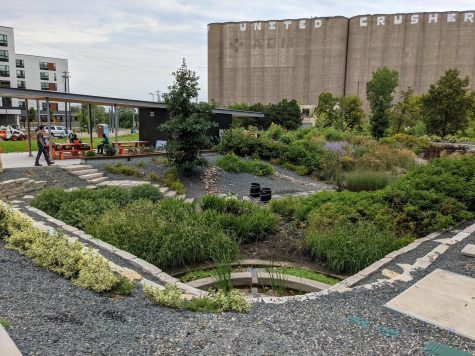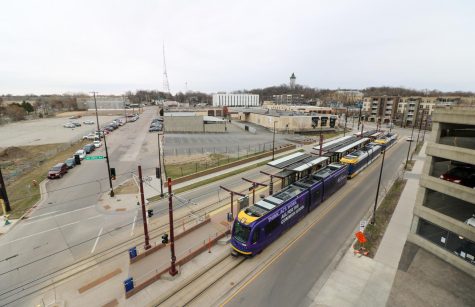Ten years ago, walking down Fourth Street in Prospect Park was a different experience.
There were empty lots, run-down warehouses and a “forest of grain elevators,” according to Prospect Park Association (PPA) member Richard Gilyard. The abandoned buildings invited teenagers seeking adventure and not much else.
Today, there are new apartment buildings and restaurants, all located north of University Avenue in Prospect Park. Much of the development was prompted by the addition of the Metro Green Line in 2014.
This conglomeration of new housing and businesses wasn’t a random happenstance from developers — it was created by residents who saw a chance to revitalize the neighborhood.
Community-driven development
When Gilyard heard the Green Line was going to be installed, he knew the land around the station could be developed fairly quickly.
“We thought it was the most asset-rich location in the entire metropolitan area, primarily because it’s next to the University of Minnesota,” said Gilyard. “We felt that if left to market forces, the area could develop as a kind of a stretch version of Stadium Village, [with] more student housing.”
Gilyard created the Master Planning Committee within the neighborhood organization to help determine what types of housing and businesses would be there.
“We formed a Master Planning Committee to think about what was the opportunity here,” Gilyard said. “Out of that came the vision of an urban village around the light rail station.”
Currently, there are mixed forms of housing, including elderly, student, luxury and affordable, and new businesses and restaurants.
There was also hope for district-wide resources, such as energy and storm-water management, which inspired the creation of Towerside Innovation District in 2013. Towerside members have completed a storm-water management system and renewable energy source that will be put into use in 2023.

Questions on affordability
Robin Wonsley Worlobah, Ward two city Council candidate, said six years ago she rented out a two-bedroom apartment with a roommate for a little over $800 a month. When looking into moving back into Prospect Park, she could not find an apartment that was affordable for her.
“Looking now, all the one-bedroom [apartments] were $1,300 plus,” said Wonsley Worlobah.
A one-bedroom apartment at HERE Minneapolis, which advertises itself as student housing, can go for about $1,500 a month. The only grocery store in Prospect Park is Fresh Thyme Market.
Between the apartments, grocery store and restaurants, Wonsley Worlobah does not see the new developments as friendly for working class residents.
There are affordable housing units in Prospect Park, such as Glendale Townhomes, with plans for more affordable housing to be added in 2023.
Glendale residents have been increasingly worried about privatization, as there have been plans to tear down and rebuild a mix of market-rate and affordable housing in the past 10 years.
Residents are worried that these plans would displace them across the city and destroy their current family-style townhomes. Although the plans have included affordable housing units that residents could move back into after construction, it is unsure if units would remain affordable.

The start with Surly
The shift in the neighborhood began with Surly Brewing Company. It was one of the first new developments to make its way into Prospect Park, opening in late 2014.
“We didn’t become cool until Surly’s got built,” said Jerry Stein, a PPA board member and nearly lifelong resident of Prospect Park.
At the time, it was one of five breweries within a few blocks of the Green Line, making it a spot that people could easily brewery-hop to. Surly attracted more customers into the neighborhood.
The Fresh Thyme grocery store was built in 2018. O’Shaughnessy Distilling Co. and the Malcolm Yards Market have opened this year in Prospect Park.
While some businesses came in, others got pushed out.
Tina Rexing, owner of T-Rex Cookies, used to own a shop in the Arts and Architecture building on Bedford Avenue in Prospect Park. She opened her cafe in 2015 after doing $150,000 worth of renovations to the space.
In December 2018, her shop closed down so that Vermilion Development could build apartments at the Arts and Architecture building. The developer agreed to keep a space open for Rexing’s business to move into after construction was finished, but after a year of waiting, Rexing decided to move her business outside Minneapolis.
“I think the new development could do nothing but good things to the neighborhood,” Rexing said.



















UMN0001
Nov 2, 2021 at 12:52 pm
If you want control of your living situation, then buy your property. As the U of M has grown, so has the surrounding community focus and demand by students and young professionals.
What is with the comment about Fresh Thyme Market? Great grocery store, very healthy options, and very affordable for many items.
If Robin Worlobah cannot afford a $1,500 apartment, then that is her issue, not the community. Look at her website. She has a very lengthy resume, owns her own consulting business, etc. S